How To Use Vinegar In A Reef Tank

This gizzard shad has VHS, a deadly infectious disease which causes haemorrhage. Information technology affects over l species of freshwater and marine fish in the northern hemisphere.[1]

Like humans and other animals, fish endure from diseases and parasites. Fish defences against disease are specific and non-specific. Non-specific defences include pare and scales, likewise equally the mucus layer secreted past the epidermis that traps microorganisms and inhibits their growth. If pathogens breach these defences, fish can develop inflammatory responses that increase the flow of blood to infected areas and deliver white blood cells that attempt to destroy the pathogens.
Specific defences are specialised responses to particular pathogens recognised by the fish's body, that is adaptative allowed responses.[3] In contempo years, vaccines take become widely used in aquaculture and ornamental fish, for example vaccines for comercial food fishes similar Aeromonas salmonicida,furunculosis in salmon and Lactococcosis\Streptococcosis [iv] in farmed grey mullet, Tilapia and koi herpes virus in koi.[5] [6]
Some commercially important fish diseases are VHS, ICH, and whirling disease.
Parasites [edit]




Parasites in fish are a common natural occurrence. Parasites tin provide information about host population ecology. In fisheries biology, for instance, parasite communities can be used to distinguish distinct populations of the same fish species co-inhabiting a region. Additionally, parasites possess a variety of specialized traits and life-history strategies that enable them to colonize hosts. Agreement these aspects of parasite ecology, of interest in their own right, can illuminate parasite-avoidance strategies employed past hosts.
Usually parasites (and pathogens) need to avoid killing their hosts, since extinct hosts tin can hateful extinct parasites. Evolutionary constraints may operate so parasites avert killing their hosts, or the natural variability in host defensive strategies may suffice to keep host populations feasible.[ix] Parasite infections can impair the courtship trip the light fantastic of male person threespine sticklebacks. When that happens, the females decline them, suggesting a strong mechanism for the choice of parasite resistance."[10]
Nevertheless, not all parasites desire to proceed their hosts alive, and there are parasites with multistage life cycles who go to some trouble to kill their host. For example, some tapeworms make some fish comport in such a way that a predatory bird can catch it. The predatory bird is the next host for the parasite in the next phase of its life bike.[11] Specifically, the tapeworm Schistocephalus solidus turns infected threespine stickleback white, and then makes them more buoyant so that they splash along at the surface of the water, becoming easy to run into and piece of cake to take hold of for a passing bird.[12]
Parasites can be internal (endoparasites) or external (ectoparasites). Some internal fish parasites are spectacular, such every bit the philometrid nematode Philometra fasciati which is parasitic in the ovary of female Blacktip grouper;[13] the woman parasite is a cherry worm which can reach up to forty centimetres in length, for a diameter of only i.6 millimetre; the males are tiny. Other internal parasites are found living inside fish gills, include encysted adult didymozoid trematodes,[fourteen] a few trichosomoidid nematodes of the genus Huffmanela, including Huffmanela ossicola which lives within the gill bone,[15] and the encysted parasitic turbellarian Paravortex.[xvi] Various protists and Myxosporea are too parasitic on gills, where they form cysts.
Fish gills are also the preferred habitat of many external parasites, fastened to the gill just living out of it. The most common are monogeneans and certain groups of parasitic copepods, which tin be extremely numerous.[17] Other external parasites found on gills are leeches and, in seawater, larvae of gnathiid isopods.[18] Isopod fish parasites are mostly external and feed on blood. The larvae of the Gnathiidae family and developed cymothoidids have piercing and sucking mouthparts and clawed limbs adjusted for clinging onto their hosts.[19] [20] Cymothoa exigua is a parasite of various marine fish. It causes the natural language of the fish to atrophy and takes its identify in what is believed to be the first instance discovered of a parasite functionally replacing a host structure in animals.[21]
Other parasitic disorders, include Gyrodactylus salaris, Ichthyophthirius multifiliis, cryptocaryon, velvet disease, Brooklynella hostilis, Hole in the head, Glugea, Ceratomyxa shasta, Kudoa thyrsites, Tetracapsuloides bryosalmonae, Cymothoa exigua, leeches, nematode, flukes, carp lice and salmon lice.
Although parasites are mostly considered to be harmful, the eradication of all parasites would not necessarily be beneficial. Parasites account for as much every bit or more than than half of life's diversity; they perform an important ecological part (past weakening prey) that ecosystems would have some time to adapt to; and without parasites organisms may eventually tend to asexual reproduction, diminishing the diversity of sexually dimorphic traits.[22] Parasites provide an opportunity for the transfer of genetic material between species. On rare, but significant, occasions this may facilitate evolutionary changes that would not otherwise occur, or that would otherwise have fifty-fifty longer.[23]
Beneath are some life cycles of fish parasites:
Cleaner fish [edit]
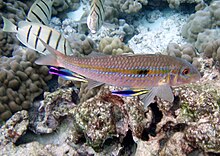
Two cleaner wrasses, Labroides phthirophagus, servicing a goatfish, Mulloidichthys flavolineatus
Some fish take advantage of cleaner fish for the removal of external parasites. The best known of these are the Bluestreak cleaner wrasses of the genus Labroides found on coral reefs in the Indian Ocean and Pacific Bounding main. These small fish maintain and so-chosen "cleaning stations" where other fish, known as hosts, will congregate and perform specific movements to attract the attention of the cleaner fish.[25] Cleaning behaviours accept been observed in a number of other fish groups, including an interesting instance between two cichlids of the aforementioned genus, Etroplus maculatus, the cleaner fish, and the much larger Etroplus suratensis, the host.[26]
More than than 40 species of parasites may reside on the skin and internally of the ocean sunfish, motivating the fish to seek relief in a number of ways.[27] [28] In temperate regions, drifting kelp fields harbour cleaner wrasses and other fish which remove parasites from the peel of visiting sunfish. In the tropics, the mola will solicit cleaner help from reef fishes. By basking on its side at the surface, the sunfish also allows seabirds to feed on parasites from their skin. Sunfish have been reported to alienation more than than x feet above the surface, possibly as another effort to dislodge parasites on the trunk.[29] [xxx]
Mass die offs [edit]

The complex life wheel of Pfiesteria piscidica. Red = toxic stages, yellow = peradventure toxic stages, bluish = passive stages
Some diseases result in mass die offs.[31] One of the more bizarre and recently discovered diseases produces huge fish kills in shallow marine waters. It is acquired past the ambush predator dinoflagellate Pfiesteria piscicida. When big numbers of fish, like shoaling provender fish, are in confined situations such as shallow bays, the excretions from the fish encourage this dinoflagellate, which is not normally toxic, to produce complimentary-pond zoospores. If the fish remain in the area, continuing to provide nourishment, then the zoospores start secreting a neurotoxin. This toxin results in the fish developing bleeding lesions, and their skin flakes off in the water. The dinoflagellates so eat the claret and flakes of tissue while the affected fish die.[32] Fish kills past this dinoflagellate are mutual, and they may also have been responsible for kills in the past which were thought to have had other causes.[32] Kills like these can be viewed as natural mechanisms for regulating the population of uncommonly abundant fish. The rate at which the kills occur increases as organically polluted country runoff increases.[33]
Wild salmon [edit]
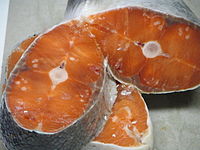
Henneguya salminicola, a parasite commonly constitute in the flesh of salmonids on the West Declension of Canada. Coho salmon
According to Canadian biologist Dorothy Kieser, protozoan parasite Henneguya salminicola is commonly institute in the flesh of salmonids. It has been recorded in the field samples of salmon returning to the Queen Charlotte Islands. The fish responds by walling off the parasitic infection into a number of cysts that contain milky fluid. This fluid is an accumulation of a large number of parasites.
Henneguya and other parasites in the myxosporean grouping accept a complex lifecycle where the salmon is ane of two hosts. The fish releases the spores later on spawning. In the Henneguya case, the spores enter a 2nd host, almost likely an invertebrate, in the spawning stream. When juvenile salmon out-migrate to the Pacific Ocean, the second host releases a stage infective to salmon. The parasite is then carried in the salmon until the next spawning bicycle. The myxosporean parasite that causes whirling affliction in trout, has a similar lifecycle.[34] Still, as opposed to whirling disease, the Henneguya infestation does not appear to cause disease in the host salmon — even heavily infected fish tend to return to spawn successfully.
According to Dr. Kieser, a lot of piece of work on Henneguya salminicola was done by scientists at the Pacific Biological Station in Nanaimo in the mid-1980s, in particular, an overview report[35] which states that "the fish that accept the longest fresh water residence fourth dimension as juveniles have the near noticeable infections. Hence in society of prevalence coho are virtually infected followed past sockeye, chinook, chum and pink." Equally well, the report says that, at the fourth dimension the studies were conducted, stocks from the middle and upper reaches of large river systems in British Columbia such equally Fraser, Skeena, Nass and from mainland coastal streams in the southern half of B.C. "are more likely to accept a depression prevalence of infection." The study besides states "It should exist stressed that Henneguya, economically deleterious though it is, is harmless from the view of public wellness. Information technology is strictly a fish parasite that cannot live in or touch warm blooded animals, including homo".
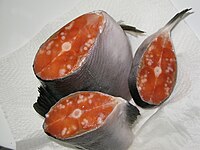
Sample of pink salmon infected with Henneguya salminicola, defenseless off Haida Gwaii, Western Canada in 2009
According to Klaus Schallie, Molluscan Shellfish Program Specialist with the Canadian Food Inspection Agency, "Henneguya salminicola is found in southern B.C. besides and in all species of salmon. I accept previously examined smoked chum salmon sides that were riddled with cysts and some sockeye runs in Barkley Sound (southern B.C., westward coast of Vancouver Island) are noted for their high incidence of infestation."
Sea lice, particularly Lepeophtheirus salmonis and a variety of Caligus species, including Caligus clemensi and Caligus rogercresseyi, tin can cause deadly infestations of both farm-grown and wild salmon.[36] [37] Ocean lice are ectoparasites which feed on mucous, claret, and skin, and drift and latch onto the pare of wild salmon during free-swimming, planktonic naupli and copepodid larval stages, which can persist for several days.[38] [39] [40] Large numbers of highly populated, open-cyberspace salmon farms can create exceptionally big concentrations of sea lice; when exposed in river estuaries containing big numbers of open-net farms, many young wild salmon are infected, and do non survive as a issue.[41] [42] Developed salmon may survive otherwise disquisitional numbers of sea lice, but small, thin-skinned juvenile salmon migrating to sea are highly vulnerable. On the Pacific coast of Canada, the louse-induced mortality of pink salmon in some regions is commonly over 80%.[43]
Farmed salmon [edit]

In 1972, Gyrodactylus salaris, also chosen salmon fluke, a monogenean parasite, spread from Norwegian hatcheries to wild salmon, and devastated some wild salmon populations.[44]
In 1984, infectious salmon anemia (ISAv) was discovered in Norway in an Atlantic salmon hatchery. Lxxx percent of the fish in the outbreak died. ISAv, a viral disease, is at present a major threat to the viability of Atlantic salmon farming. It is at present the first of the diseases classified on List Ane of the European Committee's fish health regime. Amongst other measures, this requires the total eradication of the unabridged fish stock should an outbreak of the disease exist confirmed on any subcontract. ISAv seriously affects salmon farms in Republic of chile, Kingdom of norway, Scotland and Canada, causing major economic losses to infected farms.[45] As the name implies, it causes astringent anemia of infected fish. Different mammals, the red blood cells of fish have Deoxyribonucleic acid, and can become infected with viruses. The fish develop pale gills, and may swim shut to the water surface, gulping for air. However, the affliction tin also develop without the fish showing any external signs of illness, the fish maintain a normal appetite, and then they suddenly dice. The disease can progress slowly throughout an infected farm and, in the worst cases, death rates may approach 100 percent. It is besides a threat to the dwindling stocks of wild salmon. Management strategies include developing a vaccine and improving genetic resistance to the illness.[46]
In the wild, diseases and parasites are normally at low levels, and kept in bank check by natural predation on weakened individuals. In crowded net pens they tin become epidemics. Diseases and parasites besides transfer from farmed to wild salmon populations. A recent report in British Columbia links the spread of parasitic sea lice from river salmon farms to wild pink salmon in the aforementioned river."[47] The European Committee (2002) ended "The reduction of wild salmonid abundance is also linked to other factors just there is more and more scientific testify establishing a directly link between the number of lice-infested wild fish and the presence of cages in the same estuary."[48] It is reported that wild salmon on the west coast of Canada are being driven to extinction by sea lice from nearby salmon farms.[49] Antibiotics and pesticides are often used to command the diseases and parasites.
Coral reef fish [edit]


Coral reef fish are characterized by high biodiversity. Every bit a result parasites of coral reef fish show tremendous variety. Parasites of coral reef fish include nematodes, Platyhelminthes (cestodes, digeneans, and monogeneans), leeches, parasitic crustaceans such as isopods and copepods,[51] [52] [53] and various microorganisms such as myxosporidia and microsporidia. Some of these fish parasites have heteroxenous life cycles (i.east. they accept several hosts) amongst which sharks (sure cestodes) or molluscs (digeneans). The high biodiversity of coral reefs increases the complexity of the interactions between parasites and their various and numerous hosts. Numerical estimates of parasite biodiversity take shown that certain coral fish species have up to 30 species of parasites.[51] [52] [53] [54] The mean number of parasites per fish species is well-nigh x.[51] [52] [53] This has a issue in term of co-extinction. Results obtained for the coral reef fish of New Caledonia propose that extinction of a coral reef fish species of average size would eventually issue in the co-extinction of at least ten species of parasites.[51]
Aquarium fish [edit]

Ornamental fish kept in aquariums are susceptible to numerous diseases.
In most aquarium tanks, the fish are at high concentrations and the volume of water is express. This means that communicable diseases tin spread rapidly to most or all fish in a tank. An improper nitrogen cycle, inappropriate aquarium plants and potentially harmful freshwater invertebrates can straight harm or add to the stresses on ornamental fish in a tank. Despite this, many diseases in convict fish can be avoided or prevented through proper h2o conditions and a well-adjusted ecosystem within the tank. Ammonia poisoning is a common affliction in new aquariums, especially when immediately stocked to full chapters.
Due to their generally small size and the low toll of replacing diseased or dead aquarium fish, the price of testing and treating diseases is often seen as more than problem than the value of the fish.
Allowed system [edit]
Immune organs vary past blazon of fish.[55] In the jawless fish (lampreys and hagfish), true lymphoid organs are absent. These fish rely on regions of lymphoid tissue within other organs to produce immune cells. For example, erythrocytes, macrophages and plasma cells are produced in the anterior kidney (or pronephros) and some areas of the gut (where granulocytes mature.) They resemble primitive bone marrow in hagfish. Cartilaginous fish (sharks and rays) take a more advanced immune system. They accept three specialized organs that are unique to chondrichthyes; the epigonal organs (lymphoid tissue like to mammalian bone) that surround the gonads, the Leydig's organ inside the walls of their esophagus, and a screw valve in their intestine. These organs house typical immune cells (granulocytes, lymphocytes and plasma cells). They as well possess an identifiable thymus and a well-adult spleen (their nearly important allowed organ) where various lymphocytes, plasma cells and macrophages develop and are stored. Chondrostean fish (sturgeons, paddlefish and bichirs) possess a major site for the product of granulocytes within a mass that is associated with the meninges (membranes surrounding the central nervous organisation.) Their middle is frequently covered with tissue that contains lymphocytes, reticular cells and a pocket-size number of macrophages. The chondrostean kidney is an important hemopoietic organ; where erythrocytes, granulocytes, lymphocytes and macrophages develop.
Like chondrostean fish, the major immune tissues of bony fish (or teleostei) include the kidney (especially the anterior kidney), which houses many unlike immune cells.[56] In improver, teleost fish possess a thymus, spleen and scattered immune areas within mucosal tissues (due east.g. in the skin, gills, gut and gonads). Much similar the mammalian allowed system, teleost erythrocytes, neutrophils and granulocytes are believed to reside in the spleen whereas lymphocytes are the major cell type found in the thymus.[57] [58] In 2006, a lymphatic arrangement similar to that in mammals was described in one species of teleost fish, the zebrafish. Although not confirmed as even so, this organisation presumably volition be where naive (unstimulated) T cells accumulate while waiting to meet an antigen.[59]
Spreading disease and parasites [edit]
The capture, transportation and culture of bait fish can spread dissentious organisms between ecosystems, endangering them. In 2007, several American states, including Michigan, enacted regulations designed to slow the spread of fish diseases, including viral hemorrhagic septicemia, by bait fish.[60] Because of the take a chance of transmitting Myxobolus cerebralis (whirling disease), trout and salmon should not be used as bait. Anglers may increase the possibility of contamination by emptying bait buckets into fishing venues and collecting or using bait improperly. The transportation of fish from ane location to another can break the constabulary and crusade the introduction of fish and parasites conflicting to the ecosystem.
Eating raw fish [edit]
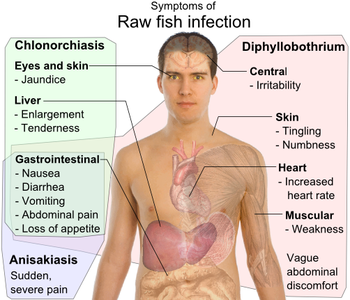
Differential symptoms of parasite infection by raw fish: Clonorchis sinensis (a trematode/fluke), Anisakis (a nematode/roundworm) and Diphyllobothrium a (cestode/tapeworm),[61] all have gastrointestinal, merely otherwise distinct, symptoms.[62] [63] [64] [65]
Though not a health concern in thoroughly cooked fish, parasites are a concern when human being consumers swallow raw or lightly preserved fish such every bit sashimi, sushi, ceviche, and gravlax. The popularity of such raw fish dishes makes it important for consumers to be enlightened of this risk. Raw fish should be frozen to an internal temperature of −20 °C (−4 °F) for at least seven days to kill parasites. It is important to be aware that dwelling freezers may not exist cold plenty to impale parasites.[66] [67]
Traditionally, fish that live all or function of their lives in fresh water were considered unsuitable for sashimi due to the possibility of parasites (see Sashimi article). Parasitic infections from freshwater fish are a serious problem in some parts of the world, particularly Southeast Asia. Fish that spend part of their life bicycle in salt water, like salmon, tin also be a problem. A study in Seattle, Washington showed that 100% of wild salmon had roundworm larvae capable of infecting people. In the same study farm-raised salmon did not have whatsoever roundworm larvae.[68] Historically, parasite infection of humans eating raw fish has been rare in the adult world, though a 2020 meta-assay of available information shows that since 1980 in that location has been a precipitous increase of parasites in the types of marine fish that are eaten uncooked.[69]
There are three primary kinds of parasites: Clonorchis sinensis (a trematode/fluke), Anisakis (a nematode/roundworm) and Diphyllobothrium (a cestode/tapeworm). Infection by the fish tapeworm Diphyllobothrium latum is seen in countries where people eat raw or undercooked fish, such equally some countries in Asia, Eastern Europe, Scandinavia, Africa, and North and South America.[70] Infection hazard of anisakis is particularly college in fishes which may live in a river such equally salmon (shake) in Salmonidae, mackerel (saba). Such parasite infections tin can generally exist avoided by boiling, burning, preserving in common salt or vinegar, or freezing overnight. Fifty-fifty Japanese people never consume raw salmon or ikura (salmon roe), and even if they seem raw, these foods are not raw only are frozen overnight to prevent infections from parasites, particularly anisakis.
Beneath are some life cycles of fish parasites that can infect humans:
-

-

Life bicycle of the parasitic Anisakis worm
-

-

Encounter also [edit]
- Bath treatment (fishkeeping)
- Cyanotoxin
- Diseases and parasites in cod
- European Community Reference Laboratory for Fish Diseases
- Fish farming
- Fish kill
- Fish toxins
- Fish medicine
- List of aquarium diseases
- Mathematical modelling of infectious disease
- Red tide
- Veterinary parasitology
Citations [edit]
- ^ Disease Factsheets: Viral Hemorrhagic Septicemia Iowa State University, The Heart for Food Security & Public Wellness. Last updated May 17, 2007. Retrieved on 2007-07-12.
- ^ Lom J, Dyková I (2005). "Microsporidian xenomas in fish seen in wider perspective". Folia Parasitologica. 52 (1–2): 69–81. doi:10.14411/fp.2005.010. PMID 16004366.
- ^ Helfman G., Collette B., & Facey D.: The Diversity of Fishes, Blackwell Publishing, pp 95-96, 1997, ISBN 0-86542-256-7
- ^ Rao, S, Byadgi, O, Pulpipat, T, Wang, P-C, Chen, S-C. Efficacy of a formalin-inactivated Lactococcus garvieae vaccine in farmed grey mullet (Mugil cephalus). J Fish Dis. 2020; 43: 1579– 1589. https://doi.org/10.1111/jfd.13260
- ^ Cipriano RC (2001) "Furunculosis And Other Diseases Acquired By Aeromonas salmonicida" Archived 2009-05-07 at the Wayback Machine Fish Disease Leaflet 66, The states Section of the Interior.
- ^ Hartman KH et al. (2004) "Koi Canker Virus (KHV) Disease". Fact Sheet VM-149. University of Florida Establish of Food and Agricultural Sciences.
- ^ R. C. Brusca; M. R. Gilligan (1983). "Natural language replacement in a marine fish (Lutjanus guttatus) by a parasitic isopod (Crustacea: Isopoda)". Copeia. 1983 (3): 813–816. doi:10.2307/1444352. JSTOR 1444352.
- ^ "Protozoa Infecting Gills and Skin". The Merck Veterinary Transmission. Archived from the original on 3 March 2016. Retrieved 4 November 2019.
- ^ Moyle and Cech, 2004, folio 615
- ^ Bronseth, T; Folstad, I (1997). "The furnishings of parasites on courtship dance in threespine sticklebacks: More meets the eye?". Canadian Periodical of Zoology. 75 (4): 589–594. doi:10.1139/z97-073. [ permanent expressionless link ]
- ^ Milinski, Manfred M (1985). "Risk of Predation of Parasitized Sticklebacks (Gasterosteus Aculeatus L.) Nether Contest for Food". Behaviour. 93 (14): 203–216. doi:ten.1163/156853986X00883.
- ^ LoBue, C. P.; Bell, One thousand. A. (1993). "Phenotypic manipulation past the cestode parasite Schistocephalus solidus of its intermediate host, Gasterosteus aculeatus, the threespine stickleback". American Naturalist. 142 (4): 725–735. doi:10.1086/285568. PMID 19425968. S2CID 40173189.
- ^ Moravec, František; Justine, Jean-Lou (2014). "Philometrids (Nematoda: Philometridae) in carangid and serranid fishes off New Caledonia, including three new species". Parasite. 21: 21. doi:ten.1051/parasite/2014022. ISSN 1776-1042. PMC4023622. PMID 24836940.

- ^ Pozdnyakov, S. Due east. & Gibson, D. I. (2008). Family Didymozoidae Monticelli, 1888. In R. A. Bray, D. I. Gibson & A. Jones (Eds.), Keys to the Trematoda, Vol. 3 (pp. 631-734). London: CAB International and The Natural History Museum.
- ^ Justine, JL. (September 2004). "Three new species of Huffmanela Moravec, 1987 (Nematoda: Trichosomoididae) from the gills of marine fish off New Caledonia". Systematic Parasitology. 59 (1): 29–37. doi:10.1023/B:SYPA.0000038442.25230.8b. PMID 15318018. S2CID 29105973.
- ^ Cannon, L. R. One thousand.; Lester, R. J. G. (1988). "Two turbellarians parasitic in fish". Diseases of Aquatic Organisms. five: 15–22. doi:10.3354/dao005015.
- ^ Kearn, K. C. (2004). Leeches, Lice and Lampreys. A natural history of skin and gill parasites of fishes. Dordrecht: Springer.
- ^ Grutter, A. S. (1994). "Spatial and temporal variations of the ectoparasites of 7 reef fish species from Lizard Island and Heron Isle, Commonwealth of australia". Marine Ecology Progress Series. 115: 21–30. doi:10.3354/meps115021.
- ^ Ruppert, Edward E.; Trick, Richard, South.; Barnes, Robert D. (2004). Invertebrate Zoology (7 ed.). Cengage Learning. pp. 661–667. ISBN978-81-315-0104-seven.
- ^ Shields, Jeffrey. "Epicaridea: The parasitic isopods of Crustacea". Virginia Institute of Marine Science. Retrieved 23 March 2014.
- ^ Brusca, R. C.; Gilligan, M. R. (1983). "Tongue replacement in a marine fish (Lutjanus guttatus) by a parasitic isopod (Crustacea: Isopoda)". Copeia. 1983 (iii): 813–816. doi:10.2307/1444352. JSTOR 1444352.
- ^ Holt RD (2010). "IJEE Soapbox". Israel Journal of Ecology and Evolution. 56 (3): 239–250. doi:10.1560/IJEE.56.3-iv.239.
- ^ Claude Combes, The Art of beingness a Parasite, U. of Chicago Press, 2005
- ^ Worsham, McLean L. D.; Huffman, David G.; Moravec, Frantisek; Gibson, J. Randy (2016). "The life cycle of Huffmanela huffmani Moravec, 1987(Nematoda: Trichosomoididae), an endemic marine-relict parasite of Centrarchidae from a Central Texas spring". Folia Parasitologica. 63. doi:10.14411/fp.2016.020. ISSN 0015-5683. PMID 27312028.

- ^ Helfman 1000., Collette B., & Facey D.: The Diversity of Fishes, Blackwell Publishing, p 380, 1997, ISBN 0-86542-256-7
- ^ Wyman, Richard 50.; Ward, Jack A. (1972). "A Cleaning Symbiosis betwixt the Cichlid Fishes Etroplus maculatus and Etroplus suratensis. I. Description and Possible Evolution". Copeia. 1972 (four): 834–838. doi:10.2307/1442742. JSTOR 1442742.
- ^ Thys, Tierney. "Molidae Descriptions and Life History". OceanSunfish.org. Retrieved 8 May 2007.
- ^ K. McGrouther (November 2004). "Ocean Sunfish Stranding". Australian Museum Online. Retrieved eleven May 2007.
- ^ "Mola (Sunfish)". National Geographic. Retrieved eight May 2007.
- ^ Thys, Tierney. "Molidae information and research". OceanSunfish.org. Retrieved xi May 2007.
- ^ Moyle and Cech, 2004, page 466
- ^ a b Burkholder JM, Glasgow HB and Hobbs CW (1995) "Fish kills linked to a toxic ambush-predator dinoflagellate: distribution and environmental weather" Marine Ecology Progress Serial.
- ^ Magnien, RE (2001). "The Dynamics of Science, Perception, and Policy during the Outbreak of Pfiesteria in the Chesapeake Bay". BioScience. 51 (10): 843–852. doi:10.1641/0006-3568(2001)051[0843:TDOSPA]2.0.CO;2.
- ^ Crosier, Danielle M.; Molloy, Daniel P.; Bartholomew, Jerri. "Whirling Affliction – Myxobolus cerebralis" (PDF). Archived from the original (PDF) on sixteen Feb 2008. Retrieved 13 Dec 2007.
- ^ N.P. Boyce; Z. Kabata; L. Margolis (1985). "Investigation of the Distribution, Detection, and Biology of Henneguya salminicola (Protozoa, Myxozoa), a Parasite of the Flesh of Pacific Salmon". Canadian Technical Written report of Fisheries and Aquatic Sciences (1450): 55.
- ^ Body of water Lice and Salmon: Elevating the dialogue on the farmed-wild salmon story Archived December fourteen, 2010, at the Wayback Machine Watershed Watch Salmon Society, 2004.
- ^ Bravo, S. (2003). "Bounding main lice in Chilean salmon farms". Bull. Eur. Assoc. Fish Pathol. 23, 197–200.
- ^ Morton, A.; Routledge, R.; Peet, C.; Ladwig, A. (2004). "Ocean lice (Lepeophtheirus salmonis) infection rates on juvenile pink (Oncorhynchus gorbuscha) and chum (Oncorhynchus keta) salmon in the nearshore marine surround of British Columbia, Canada". Canadian Journal of Fisheries and Aquatic Sciences. 61 (ii): 147–157. doi:10.1139/f04-016.
- ^ Peet, C. R. 2007. Thesis, University of Victoria.
- ^ Krkošek, M.; Gottesfeld, A.; Proctor, B.; Rolston, D.; Carr-Harris, C.; Lewis, Thousand.A. (2007). "Effects of host migration, diversity, and aquaculture on disease threats to wild fish populations". Proceedings of the Royal Society of London, Series B. 274 (1629): 3141–3149. doi:ten.1098/rspb.2007.1122. PMC2293942. PMID 17939989.
- ^ Morton, A.; Routledge, R.; Krkošek, Yard. (2008). "Sea louse infestation in wild juvenile salmon and Pacific herring associated with fish farms off the east-primal coast of Vancouver Island, British Columbia". North American Periodical of Fisheries Management. 28 (2): 523–532. doi:10.1577/m07-042.one.
- ^ Krkošek, M.; Lewis, Thou.A.; Morton, A.; Frazer, L.Due north.; Volpe, J.P. (2006). "Epizootics of wild fish induced by subcontract fish". Proceedings of the National Academy of Sciences. 103 (42): 15506–15510. doi:x.1073/pnas.0603525103. PMC1591297. PMID 17021017.
- ^ Krkošek, Martin, et al. Report: "Failing Wild Salmon Populations in Relation to Parasites from Farm Salmon", Science: Vol. 318. no. 5857, pp. 1772 - 1775, 14 Dec 2007.
- ^ Stead, SM and Laird lLM (2002) Handbook of salmon farming, page 348, Birkhäuser. ISBN 978-i-85233-119-1
- ^ New Brunswick to help Chile vanquish disease Fish Data and Services
- ^ Fact Sheet - Atlantic Salmon Aquaculture Research Archived December 29, 2010, at the Wayback Machine Fisheries and Oceans Canada. Retrieved 12 May 2009.
- ^ Seafood Choices Alliance (2005) It's all about salmon Archived 2015-09-24 at the Wayback Machine
- ^ Scientific Bear witness Archived September nineteen, 2006, at the Wayback Motorcar.
- ^ Krkosek M, Ford JS, Morton A, Lele Due south, Myers RA and Lewis MA (2007) Declining Wild Salmon Populations in Relation to Parasites from Farm Salmon Science, 318, 5857: 1772.
- ^ Agnew W, Barnes AC (May 2007). "Streptococcus iniae: an aquatic pathogen of global veterinarian significance and a challenging candidate for reliable vaccination". Vet Microbiol. 122 (one–2): 1–15. doi:10.1016/j.vetmic.2007.03.002. PMID 17418985.
- ^ a b c d Justine, J-L.; Beveridge, I.; Boxshall, GA.; Bray, RA.; Miller, TL.; Moravec, F.; Trilles, JP.; Whittington, ID. (2012). "An annotated list of fish parasites (Isopoda, Copepoda, Monogenea, Digenea, Cestoda, Nematoda) collected from Snappers and Bream (Lutjanidae, Nemipteridae, Caesionidae) in New Caledonia confirms high parasite biodiversity on coral reef fish". Aquat Biosyst. 8 (one): 22. doi:10.1186/2046-9063-viii-22. PMC3507714. PMID 22947621.

- ^ a b c Justine, J-L.; Beveridge, I.; Boxshall, GA.; Bray, RA.; Moravec, F.; Trilles, JP.; Whittington, ID. (November 2010). "An annotated listing of parasites (Isopoda, Copepoda, Monogenea, Digenea, Cestoda and Nematoda) collected in groupers (Serranidae, Epinephelinae) in New Caledonia emphasizes parasite biodiversity in coral reef fish". Folia Parasitol (Praha). 57 (4): 237–62. doi:ten.14411/fp.2010.032. PMID 21344838. Free PDF

- ^ a b c Justine, J.-L., Beveridge, I., Boxshall, G. A., Bray, R. A., Moravec, F. & Whittington, I. D. 2010: An annotated list of fish parasites (Copepoda, Monogenea, Digenea, Cestoda and Nematoda) collected from Emperors and Emperor Bream (Lethrinidae) in New Caledonia further highlights parasite biodiversity estimates on coral reef fish. Zootaxa, 2691, 1-40. Free PDF

- ^ Justine, J.-50. 2010: Parasites of coral reef fish: how much exercise we know? With a bibliography of fish parasites in New Caledonia. Belgian Journal of Zoology, 140 (Suppl.), 155-190. Gratis PDF Archived 2016-03-07 at the Wayback Motorcar

- ^ A.G. Zapata, A. Chiba and A. Vara. Cells and tissues of the immune system of fish. In: The Fish Immune System: Organism, Pathogen and Surround. Fish Immunology Serial. (eds. Grand. Iwama and T.Nakanishi,), New York, Academic Printing, 1996, pp. 1–55.
- ^ D.P. Anderson. Fish Immunology. (South.F. Snieszko and H.R. Axelrod, eds), Hong Kong: TFH Publications, Inc. Ltd., 1977.
- ^ Chilmonczyk, Southward. (1992). "The thymus in fish: development and possible part in the allowed response". Almanac Review of Fish Diseases. 2: 181–200. doi:10.1016/0959-8030(92)90063-4.
- ^ Hansen, J.D.; Zapata, A.One thousand. (1998). "Lymphocyte evolution in fish and amphibians". Immunological Reviews. 166: 199–220. doi:10.1111/j.1600-065x.1998.tb01264.ten. PMID 9914914. S2CID 7965762.
- ^ Kucher; et al. (2006). "Evolution of the zebrafish lymphatic arrangement requires VegFc signalling". Current Biological science. 16 (12): 1244–1248. doi:ten.1016/j.cub.2006.05.026. PMID 16782017. S2CID 428224.
- ^ DNR Angling Regulation Changes Reflect Illness Management Concerns with VHS
- ^ WaiSays: Nearly Consuming Raw Fish Retrieved on Apr 14, 2009
- ^ For Chlonorchiasis: Public Health Bureau of Canada > Clonorchis sinensis - Material Safety Information Sheets (MSDS) Retrieved on April 14, 2009
- ^ For Anisakiasis: WrongDiagnosis: Symptoms of Anisakiasis Retrieved on April 14, 2009
- ^ For Diphyllobothrium: MedlinePlus > Diphyllobothriasis Updated by: Arnold L. Lentnek, Md. Retrieved on April xiv, 2009
- ^ For symptoms of diphyllobothrium due to vitamin B12-deficiency Academy of Maryland Medical Center > Megaloblastic (Pernicious) Anemia Retrieved on April 14, 2009
- ^ Parasites in Marine Fishes University of California Nutrient Scientific discipline & Applied science Department Sea Grant Extension Program Archived 2011-09-27 at the Wayback Machine
- ^ Vaughn Thousand. Sushi and Sashimi Rubber
- ^ Deardorff, TL; ML Kent (one July 1989). "Prevalence of larval Anisakis simplex in pen-reared and wild-defenseless salmon (Salmonidae) from Puget Audio, Washington". Journal of Wild animals Diseases. 25 (3): 416–419. doi:10.7589/0090-3558-25.3.416. PMID 2761015.
- ^ Fiorenza, Evan A.; Wendt, Catrin A.; Dobkowski, Katie A.; King, Teri L.; Pappaionou, Marguerite; Rabinowitz, Peter; Samhouri, Jameal F.; Wood, Chelsea L. (2020). "It's a wormy world: Meta‐analysis reveals several decades of change in the global affluence of the parasitic nematodes Anisakis SPP. And Pseudoterranova SPP. In marine fishes and invertebrates". Global Alter Biological science. 26 (5): 2854–2866. Bibcode:2020GCBio..26.2854F. doi:ten.1111/gcb.15048. PMID 32189441.
- ^ U.S. National Library of Medicine, Medline Plus, "Fish Tapeworm," [one].
General and cited references [edit]
- Fish Diseases (2017) Edited By Takashi Aoki, UNESCO-EOLSS Publishers.ISBN 9781780210407
- Axelrod Hour, Untergasser D (1989). Handbook of fish diseases. Neptune, NJ: T.F.H. Publications. ISBN978-0-86622-703-2.
- Andrews C (1988). The Manual of Fish Health. Stillwater, MN: Voyageur Press. ISBN978-ane-56465-160-0.
- Exell A, Burgess PH, Bailey MT (29 May 1999). A-Z of Tropical Fish Diseases and Wellness Problems . New York, Due north.Y: Howell Book Firm. ISBN978-one-58245-049-0.
- Fairfield, T (2000). A commonsense guide to fish health. Woodbury, Due north.Y: Barron's Educational Series. ISBN978-0-7641-1338-three.
- U.S. Nutrient and Drug Assistants (FDA) (2001) Compliance Regulatory Information: Fish and Fisheries Products Hazards and Controls Guidance Third edition.
- Rohde, Klaus (2005) Marine Parasitology Csiro Publishing. ISBN 9780643099272.
- Moyle, PB and Cech, JJ (2004) Fishes, An Introduction to Ichthyology. 5th Ed, Benjamin Cummings. ISBN 978-0-13-100847-2
- Woo PTK (1995) Fish Diseases and Disorders: Volume one: Protozoan and Metazoan Infections Cabi Series. ISBN 9780851988238.
- Woo PTK (2011) Fish Diseases and Disorders: Volume 2: Non-Infectious Disorders Cabi Series. ISBN 9781845935535.
- Woo PTK (2011) Fish Diseases and Disorders: Book 3: Viral, Bacterial and Fungal Infections Cabi Serial. ISBN 9781845935542.
Further reading [edit]
- Sea Lice and Salmon: Elevating the dialogue on the farmed-wild salmon story Watershed Sentry Salmon Society, 2004.
- Krkoek, Martin; et al. (2007). "Failing Wild Salmon Populations in Relation to Parasites from Subcontract Salmon". Scientific discipline. 318 (5857): 1772–1775. doi:10.1126/science.1148744. PMID 18079401. S2CID 86544687.
External links [edit]
- Help with Stress & Illness
- The European Wedlock puts in place a framework of measures to combat sure fish diseases effectively and to foreclose their spread.
- Watershed Watch Salmon Society A British Columbia advocacy group for wild salmon
- Wild Salmon in Trouble: The Link Between Farmed Salmon, Sea Lice and Wild Salmon - Watershed Watch Salmon Society. Animated brusk video based on peer-reviewed scientific research, with subject background article Watching out for Wild Salmon.
- Aquacultural Revolution: The scientific instance for irresolute salmon farming - Watershed Watch Salmon Order. Curt video documentary. Prominent scientists and Offset Nation representatives speak their minds nigh the salmon farming manufacture and the furnishings of sea lice infestations on wild salmon populations.
- Body of water Lice Coastal Alliance for Aquaculture Reform. An overview of farmed- to wild-salmon interactive effects.
- Salmon Farming Bug Coastal Brotherhood for Aquaculture Reform. An overview of environmental impacts of salmon farming.
- Fish farms drive wild salmon populations toward extinction Biology News Net. December 13, 2007.
- Salmonid parasites University of St Andrews Marine Environmental Research Group.
- FishPEST - Fish Parasite Ecology Software Tool
How To Use Vinegar In A Reef Tank,
Source: https://en.wikipedia.org/wiki/Fish_disease_and_parasites
Posted by: germanhaing1965.blogspot.com


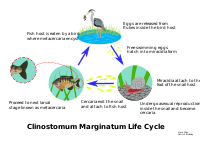
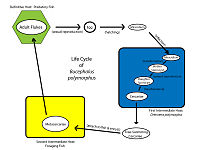
![Life cycle of the parasitic nematode Huffmanela huffmani[24]](https://upload.wikimedia.org/wikipedia/commons/thumb/d/d5/Life_cycle_of_Huffmanela_huffmani_Moravec%2C_1987.png/200px-Life_cycle_of_Huffmanela_huffmani_Moravec%2C_1987.png)



0 Response to "How To Use Vinegar In A Reef Tank"
Post a Comment